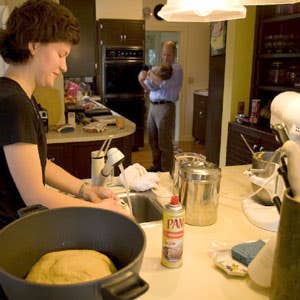
It’s All Kosher
In my last visit to my sister-in-law Rebecca Ben-Gideon's house in Madison, Wisconsin, I had the chance to watch her make challah, a traditional Jewish bread, as she does every Friday in preparation for the Sabbath. Working at the counter of her bright, airy kitchen, she started with a ball of spongy dough that had been rising on her kitchen counter all morning and divided it into six long strands, which she quickly and expertly wove together to form an intricate loaf.
For the past eight years, ever since I met my husband, Josh Wand, his sister Rebecca and their mother, Barbara Wand, have been teaching me their favorite recipes. Much of Jewish observance revolves around food, and so in passing along the recipes they use for latkes at Hanukkah and for honey cake at Rosh Hashanah, they have also been sharing with me one of the most integral aspects of their faith. In the process, my in-laws have also revealed something more basic about Jewish cooking: the art and science of keeping a kosher kitchen.
When Rebecca and her husband, Joshua Ben-Gideon, who are both rabbis in the Conservative branch of Judaism, moved with their three children to Madison earlier this year, they were confronted anew with figuring out how best to organize their kitchen to accommodate the laws of kashrut, the dietary regulations that observant Jews follow the world over. At their core, these ancient laws are fairly simple: meat and dairy may not be mixed at any time; meat must come from herbivorous fowl or from an animal that has cloven hooves and chews its cud, and it must be slaughtered and prepared properly; and fish may be eaten only if it has both fins and scales. In practice, however, these rules present some interesting challenges, because the plates, utensils, and cooking implements used for meat and dairy foods must be kept separate to prevent any transfer (even microscopic) of one kind of food to the other.
The kitchen of the Ben-Gideons' new home had not been designed with kosher cooking in mind, and they knew that they would not be able to remodel it right away, but its generous size appealed to them because they often have relatives (and their three children) helping them cook. "The most important thing was to find a house that would work for our family," Joshua explained to me. "We could have figured out how to work with almost any kitchen." Some elements of the existing design happened to meet their needs perfectly. Two wide, glass-fronted cabinets near the door to the dining room proved ideal for housing their two sets of dishes, a white set for meat meals and a blue-rimmed set for dairy meals. Felicitously, the large island at the opposite end of the kitchen also had cabinets and drawers on two sides—a convenient arrangement for keeping cookware separate. Additional cabinets near the sink provided space for the pots and pans used for pareve foods (those that are neither meat nor dairy, like vegetables). To make the kitchen easier to navigate, Rebecca and Joshua labeled the insides of cabinets and drawers with stickers that say "Meat" and "Dairy", so if a guest has to find the proper spoon to use for stirring milk into coffee, the labels will point the way.
Other problems could not be solved quite so easily. Unlike the kitchen in their last home, this one has only one dishwasher, so the couple decided to devote it exclusively to dairy dishes, which they use the most frequently, and to hand-wash everything else. Likewise, they don't have room for separate magnetic strips for holding meat and dairy knives, so both sets are kept in one knife block, and they use two different brands to distinguish them. As for the daily routines that are not dependent on the kitchen's design, they were simply carried over from their previous house—for instance, the use of different-colored dish towels and sponges for cleaning and drying meat and dairy items.
The thought and organization invested in this kitchen make it a remarkably efficient and relaxing work space. Whenever I've helped make a meal there, I've found that I can position myself in one part of the kitchen and have all the appropriate cooking tools within easy reach—something I've never been able to achieve in my own kitchen. On my most recent visit, while watching Rebecca form and bake the challah that she would later bless at the start of our meal, I was struck by another of the kitchen's features, one far more profound than how accessible the pots and pans are: the real reward of keeping a kosher kitchen is that it turns the preparing of food into an act of observance, a daily sacrament that makes the feeding of family a way of feeding the soul as well.
Keep Reading
Continue to Next Story










